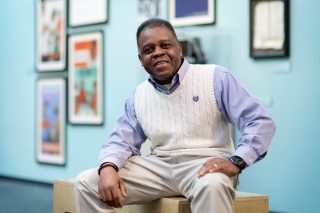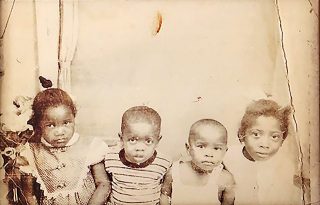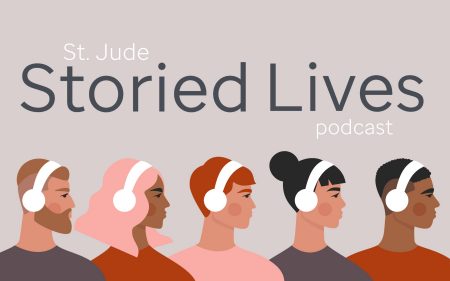
An Open Door: Cedric's Story
As the son of sharecroppers in the 1960s, two-year-old Cedric faced nearly insurmountable obstacles when he developed kidney cancer. St. Jude was there to help save his life.

February 26, 2019 • 6 min

Doris McCollins put her ailing child in the car and raced off toward the clinic, fully aware she was also bound for another brush with Mississippi’s racial codes. Upon arriving, she and 2-year-old Cedric had to enter through the waiting-room door labeled “Colored.”
On that winter morning more than a half-century ago, segregated facilities remained a part of life across much of the South, but they were among the least of Doris’ worries. She could think of nothing other than getting help for Cedric, who suffered sharp stomach pains and had a mysterious hardness to his abdomen.
The doctor who saw Cedric couldn’t cure him, but he set the toddler on a path to healing that would lead through another, starkly different set of doors. Suspecting a serious disease lay at the root of Cedric’s symptoms, he referred the family to St. Jude Children’s Research Hospital®, located 80 miles north and a world away from their rural home.
St. Jude, then just five years old, offered hope for kids with cancer and other catastrophic diseases. The facility had another major distinction: It was the first fully integrated children’s hospital in the South — a place where black and white patients received treatment together and dined together, where African-Americans got hired as doctors, researchers and nurses.
A place where the doors opened to all races.
After passing through those doors, Cedric defied predictions by surviving the kidney cancer afflicting him, and he’s been beating the odds ever since. The son of former sharecroppers, he earned a college degree, got married and, contrary to doctors’ predictions, was able to have children. He became a biologist and embarked on a career with a federal health agency.
“I got a second chance at life,” he says. “I try to live every day as if it’s my last.”
A premiere agency
It’s a gray and dreary winter day, but the voice on the other end of the phone call positively beams:
“We’ve got liquid warm sunshine in our souls.”
That’s Cedric McCollins, now 54, displaying his weather-proof, effervescent spirit.
He carries it from his home in suburban Atlanta to the gleaming office towers that serve as headquarters for the Centers for Disease Control and Prevention. McCollins unabashedly calls the CDC “one of the premiere government agencies in the country.”
He moved to Atlanta in search of big-city opportunities after graduating from Alcorn State University in 1987. After hiring on with the CDC, he worked first as a biological aide in shipping and logistics and later became a lab technician and a business specialist. He’s been involved in testing samples for such public health threats as salmonella and E. coli bacteria.
McCollins now supports programs promoting seat belt use, workplace safety, good nutrition, proper exercise and disease prevention.
“The most rewarding part is helping people stay healthy. If you can prevent something, you’re ahead of the game.”
He’s trying to guide people on a path to health that’s easier than the one he faced.
A different time
The year was 1967. The Civil Rights movement had been prodding the nation toward racial justice for more than a decade, but little progress had penetrated the hardscrabble hills and adjacent Delta region of Mississippi.
Tallahatchie County, where the McCollinses lived, had known its share of racial notoriety. In 1955, Sumner, one of the two county seats, hosted an internationally publicized trial resulting in the acquittal of two white men charged with kidnapping and murdering Emmett Till, a black Chicago teen who purportedly had whistled at or made improper advances to a white woman.
In Charleston, the other county seat, the high school continued holding segregated proms into the 21st century. Not until 2008 did the school hold its first integrated prom, an event paid for by the town’s most famous native, actor Morgan Freeman.
On the northern edge of the county, Mack and Doris McCollins worked as sharecroppers and lived in a small wood home perched on a plantation that grew cotton and corn.
Although most sharecroppers ended up in debt to the landowner, the McCollinses were fortunate enough to reap a small income each year. One reason was that they worked for another tenant with whom they were acquainted.
“Who we lived with was one of the deacons of our church,” Doris McCollins recalls. “He rented some land from the Caucasians, and since he rented the land, they allowed him to be an overseer.”
They were poor, but self-sufficient. Even happy. “We had what money couldn’t buy,” is how Doris McCollins puts it.
“I’ll tell you one thing, we had more happiness then than folks have now with all the stuff that they have.”
A sudden, scary illness
One morning Cedric got up and told his mother his stomach was hurting.
The boy had experienced stomach pains before — over the holidays, he had swallowed a Christmas ornament and some cleaning fluid — but this was different.
Doris took Cedric to the clinic in Charleston, about 15 miles away, leaving her husband to look after the couple’s other children.

With its segregated waiting rooms, the Charleston clinic was not unlike other healthcare facilities in the South and some in the North. Hospitals and clinics across the region typically maintained separate wards or wings for African-Americans — if they admitted them at all. Black doctors were scarce.
In addition to its segregated facilities, the Charleston clinic often required black sharecroppers to bring a note from their landlords approving of the office visit, Doris McCollins recalls, although she was not asked for one the day she brought Cedric.
On that morning at the clinic, the doctor who saw Cedric confirmed Doris’s fears. “This is a sick baby,” he told her.
“They recommended sending him to St. Jude. Of course, at that time I didn’t know anything about St. Jude. We were young, didn’t have any money, any insurance or anything like that.”
As the family would learn, St. Jude differed from other hospitals in the South. Founder Danny Thomas emphatically broke from the tradition of segregation, promising a hospital that would be open to all regardless of race, religion or ability to pay.
A difficult path
By the time Cedric arrived at St. Jude, in January 1967, he was pale, limp and gravely ill. The doctors diagnosed him with Wilms tumor, a type of kidney cancer. The disease had essentially destroyed one kidney.
After surgery, physicians recommended radiation, his mother says, but they had little hope that Cedric would survive.
“Since they had no hope, they gave him radiation at the highest level.”
Following the hospital stay, Cedric was so frail and thin that his eyes seemed to bulge. “He was nothing but skin and bones. Skin and bones and scales.”
The treatment at St. Jude clearly had helped Cedric, but not quite enough, his mother says. “He was not where he needed to be.”
To help get him there, Doris McCollins and other family members turned to faith.
“I had a praying mother, had a praying uncle,” she says. “They said they didn’t believe God had given us this child to take him away.”
So they prayed for Cedric. They laid hands on him. “And that’s when he began to get better. He began to eat. He began to thrive. And after thriving, he became that little boy who grew up.”
A 'blessed life'
Cedric soon was enjoying a happy, active rural childhood. He fished and played sports. He rode the pony his dad had bought.
Mostly, though, he developed a fondness for reading. Words came so easily to him that he usually took home the $25 first prize at the spelling bee held each summer in nearby Mound Bayou. He also loved science, particularly biology, which he would choose as one of his majors in college.
Even after his cancer ordeal, Cedric returned to the Charleston clinic for other ailments and appointments. He recalls that the segregation persisted until later in his childhood.
“I didn’t think about it so much at the time. I just thought that was the way things were.”
While attending Alcorn State, a historically black college located some 200 miles downstate from his home, he took a semester off to work with his dad in a cotton gin to earn spending money. “I had just pledged to a fraternity and figured I needed a car.”
With a car, the new Phi Beta Sigma was able to date, and began seeing another ASU student named Vera. They married in 1989. “That was the best thing that ever happened to me,” he says.
McCollins’ experience has filled him with gratitude and a positivity that seems almost contagious.
Last October, for the first time in decades, he returned to St. Jude for a visit. He spoke with some patients and family members, offering the kind of encouragement and hope that can only come from a survivor. McCollins plans additional visits and hopes to enlist donors for the hospital.
“There’s so much joy and happiness there despite the children who are ill. It gives me so much hope.”
He knows his experience can inspire current patients.
“I’ve had a blessed life.”







